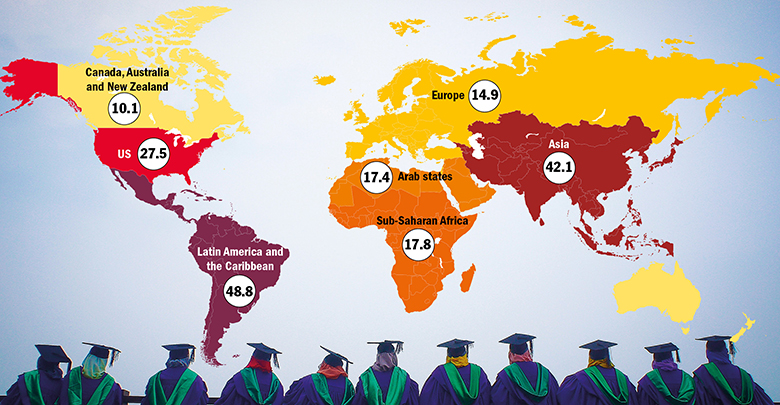One in three students globally is enrolled in private higher education institutions, according to research that reveals the huge growth and wide reach of private providers.
The analysis, the first study based on comprehensive data on the size and shape of private higher education internationally, finds that private institutions have 56.7 million students on their books, or 32.9 per cent of the world’s enrolment.
While the US has historically towered over the rest of the world in terms of the size of its private sector, the proportion of students in the country in private higher education stands at 27.5 per cent, lower than the global average, and it now accounts for only a tenth of global private enrolment.
Private universities’ share of enrolments is highest in Latin America (48.8 per cent) and Asia (42.1 per cent), but the sector is far from limited to a small number of countries: 97.6 per cent of the world’s total tertiary enrolment is in higher education systems with “dual-sector provision”, and in all regions at least 10 per cent of students are in the private sector, according to the research.
The research draws on a dataset developed by the Program for Research on Private Higher Education, a global scholarly network founded by Daniel Levy, distinguished professor in the School of Education at the State University of New York Albany. The data cover 192 countries and were sourced primarily from the Institute of Statistics at the United Nations Educational, Scientific and Cultural Organisation, as well as other cross-border agencies and national organisations.
A paper describing the dataset, newly published in the journal Higher Education, says that while higher education has “long and overwhelmingly [been] seen beyond the US as an essentially public sector function with no or only marginal private presence”, it has become “very much a dual-sector phenomenon globally”. This has occurred despite unprecedented growth in public enrolment and indicates how governments have been unable to meet soaring demand for higher education via the creation of public university systems.
|
Country |
Private enrolment (millions) |
Proportion of private enrolment (%) |
|
India |
12.44 |
58.3 |
|
US |
5.62 |
27.5 |
|
Brazil |
4.76 |
72.7 |
|
China |
4.66 |
19.6 |
|
Japan |
3.02 |
78.6 |
|
Indonesia |
2.91 |
58.2 |
|
South Korea |
2.64 |
80.7 |
|
Iran |
1.7 |
44.9 |
|
Philippines |
1.69 |
60.8 |
|
Russian Federation |
1.32 |
14.7 |
Source: Program for Research on Private Higher Education
Of the 179 countries showing enrolment by sector, only 10 nations appear to have no private higher education, according to the analysis.
Despite the wide dispersion of private higher education, enrolment in the sector concentrates mostly in developing regions.
Compared with the higher figures for Latin America and Asia, private providers account for less than a sixth of total higher education enrolment in Canada, Australia and New Zealand (10.1 per cent) and Europe (14.9) per cent.
Concentrated effort: share of private higher education enrolment by region

Note: Figures represent proportion by percentage.
Source: Program for Research on Private Higher Education
Dr Levy’s analysis indicates that the developing world holds 69.8 per cent of the world’s private higher education, versus 30.2 per cent in the developed world. Put another way, in the developed world, 25.2 per cent of enrolments are in private higher education, compared with 37.8 per cent of the developing world’s enrolment.
The country with the largest private sector is India, which is home to 21.9 per cent of global private enrolment, with more than 12 million students – more than twice the size of the US.
Private higher education also tends to concentrate in large higher education systems; the 10 countries with the largest total higher education enrolment – China, India, the US, Russia, Brazil, Indonesia, Japan, Iran, Turkey and South Korea – comprise more than half of total university enrolment globally (58.3 per cent) but an even higher share of private higher education (69.2 per cent).
However, countries with very high shares of private enrolment tend to have small higher education systems.
Dr Levy told Times Higher Education that his expectation was that, while private higher education enrolment will continue to increase in absolute terms, the sector’s share of enrolment will “level off”.
He said that this is partly because as the sector gets larger, the “challenge of increasing share becomes more difficult”.
Liz Reisberg, an independent higher education consultant and research fellow at Boston College’s Center for International Higher Education, said that private higher education is “both inevitable and necessary” as the “public sector will never have the resources to meet either the scale of demand or its diversity”.
However, she said that the quality of the private sector “remains an urgent concern”. For example, in Latin America, “while nearly every nation in the region now has an accreditation agency, none have adequate capacity to address poor quality in either the private or public sector”.
Register to continue
Why register?
- Registration is free and only takes a moment
- Once registered, you can read 3 articles a month
- Sign up for our newsletter
Subscribe
Or subscribe for unlimited access to:
- Unlimited access to news, views, insights & reviews
- Digital editions
- Digital access to THE’s university and college rankings analysis
Already registered or a current subscriber? Login








